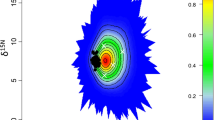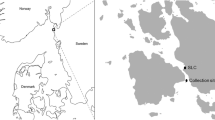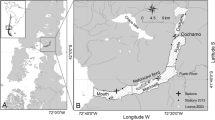Abstract
Laboratory experiments have been conducted on byssus thread production by two species of mussel, Mytilus edulis L. and Modiolus modiolus (L.), representing the epibyssate and endobyssate species of the Mytilidae, respectively. Mussels were placed in seven particle sizes of sediment ranging from 50 μm to 16 mm for 12 d. The number of byssus threads per mussel, length of threads, number of threads per particle and size of pads were then recorded. Modiolus modiolus (endobyssate) produced more threads than Mytilus edulis (epibyssate). M. edulis produced most threads in the size range 2 to 16 mm and Modiolus modiolus in the size range 500 to 1000 μm. M. modiolus produced longer threads than Mytilus edulis. Both species produced longer threads in particle sizes finer than 2 mm. M. edulis produced smaller pads than Modiolus modiolus. Both species produced larger pads in sediments coarser than 1 000 μm. Results were also analysed in terms of attachment units (a thread attached to one or more particles, or a particle to which more than one thread is attached). The thread:particle ratio of the attachment units ranged from ca. 1:10 in the finest sediments to ca. 10:1 in the coarsest sediments. Mytilus edulis attached more threads to single particles (72% of attachment units) than Modiolus modiolus (37% of attachment units). M. modiolus had a wider spread of ratios in the finer particle sizes than Mytilus edulis. The significance of our results are discussed in relation to the ecology and palaeoecology of epibyssate and endobysste species.
Similar content being viewed by others
Literature cited
Allen, J. A., Cook, M., Jackson, D. J., Preston, S., Worth, E. M. (1976). Observations on the rate of production and mechanical properties of the byssus threads of Mytilus edulis L. J. mollusc. Stud. 42:279–289
Bairati, A., Vitellaro-Zuccarello, L. (1974). The ultrastructure of the byssal apparatus of Mytilus galloprovincialis. II. Observations by microdissection and scanning electron microscopy. Mar. Biol. 28:145–158
Baird, R. H. (1966). Factors affecting the growth and condition of mussels (Mytilus edulis L.). Fishery Invest. (Ser. 2) 25(2):1–33
Brown, R. A., Seed, R. (1977). Modiolus modiolus (L.) — an autecological study. In: O'Ceidigh, P., Keegan, B. F., Boaden, P. J. S. (eds.) Biology of benthic organisms, Pergamon Press, Oxford, p. 93–100
Comely, C. A. (1978). Modiolus modiolus (L.) from the Scottish west coast. I. Biology. Ophelia 17:167–193
Cook, M. (1970). Composition of mussel and barnacle deposits at the attachment interface. In: Manly, R. S. (ed.). Adhesion in biological systems. Academic Press, New York, p. 139–150
Dare, P. J. (1971). Preliminary studies on the utilisation of the resources of spat mussels, Mytilus edulis L. occurring in Morecambe Bay, England. Int. Counc. Explor. Sea Comm. Meet. (Shellfish and Benthos Comm.) K 11:1–6
Dare, P. J. (1976). Settlement, growth and production of the mussel Mytilus edulis L. in Morecambe Bay. Fishery Invest., Lond. (Ser. 2) 28: pp 1–25
Field, J. A. (1922). Biology and economic importance of the sea mussel, Mytilus edulis. Bull. Bur. Fish, Wash. 38:127–260
Glaus, K. J. (1968). Factors influencing the production of byssus threads in Mytilus edulis. Biol. Bull. mar. biol. Lab., Woods Hole 135:p. 420
Harger, J. R. E. (1970). The effect of wave impact on some aspects of the biology of sea mussels. Veliger 12:401–414
Havinga, B. (1956). Mussel culture in the Dutch Waddensea. Rapp. P.-v. Réun. Cons. perm. int. Explor. Mer 140:5–6
Kuenen, D. J. (1942). On the distribution of mussels on the intertidal sand flats near Den Helder. Archs néerl. Zool. 6:8–158
Maas Gesteranus, R. A. (1942). On the formation of banks by Mytilus edulis L. Archs néerl. Zool. 6:283–326
Maheo, R. (1970) Etude de la pose et de l'activitié de secretion du byssus de Mytilus edulis L. Cah. Biol. mar. 11:475–490
Mason, J. (1976). Cultivation. In: Bayne, B. L. (ed.) Marine mussels. Cambridge University Press, Cambridge, p. 385–410
Meadows, P. S., Tufail, A. (1986). Bioturbation, microbial activity and sediment properties in an estuarine ecosystem. Proc. R. Soc. Edinb. (Sect. B) 90:129–142
Price, H. A. (1980). Seasonal variation in the strength of byssal attachment of the common mussel Mytilus edulis L. J. mar. biol. Ass. U.K. 60:1035–1037
Price, H. A. (1982). An analysis of the factors determining seasonal variation in the byssal attachment strength of Mytilus edulis. J. mar. biol. Ass. U.K. 62:147–155
Roberts, C. D. (1975). Investigations into a Modiolus modiolus (L.) (Mollusca: Bivalvia) community in Strangford Lough, N. Ireland. Rep. Underwat. Ass. (N.S.) 1:27–49
Scott, A. (1896). Mussels and mussel beds. Rep. Lancs. Sea-Fish. Labs 21–32
Scott, A., Baxter, T. (1905). Mussel transplantation at Morecambe Bay. Rep. Lancs. Sea-Fish. Labs 58–87
Seed, R. (1976). Ecology, In: Bayne, B. L. (ed.) Marine mussels. Cambridge University Press, Cambridge, p. 13–65
Seed, R. (1980). Shell growth and form in the Bivalvia. In: Rhoads, D. C., Lutz, R. A. (eds.) Skeletal growth in aquatic organisms. Plenum Press, New York, p. 23–67
Seed, R., Brown, R. A. (1975). The influence of reproductive cycle, growth and mortality on population structure in Modiolus modiolus (L.), Cerastoderma edule (L.), and Mytilus edulis L., (Mollusca: Bivalvia). Proc. 9th Eur. mar. Biol. Symp. 257–274 [Barnes, H. (ed.) Aberdeen University Press, Aberdeen]
Seed, R., Brown, R. A. (1977). A comparison of the reproductive cycles of Modiolus modiolus (L.), Cerastoderma (=Cardium) edule (L.), and Mytilus edulis L. in Strangford Lough, Northern Ireland. Oecologia 30:173–188
Seed, R., Brown, R. A. (1978). Growth as a strategy for survival in two marine bivalves, Cerastoderma edule and Modiolus modiolus. J. Anim. Ecol. 47:283–292
Spark, R. (1935). On the importance of quantitative investigation of the bottom fauna in marine biology. J. Cons. perm. int. Explor. Mer 10:1–19
Stanley, S. M. (1970). Relation of shell form to life habits of the Bivalvia (Mollusca). Bull. geol. Soc. Am. 125:1–496
Stanley, S. M. (1972). Functional morphology and evolution of byssally attached bivalve molluscs. J. Paleont. 46:165–213
Stasek, C. R. (1963). Geometrical form and gnomonic growth in the bivalved mollusca. J. Morph. 112:215–231
Stern, S., Achituv, Y. (1978). Effects of temperature and salinity on metabolism and byssal formation of Brachidontes variabilis. Comp. Biochem. Physiol. 59A:101–105
Tamarin, A., Lewis, P., Askey, J. (1976). The structure and formation of the byssus attachment plaque in Mytilus. J. Morph. 149: 199–222
Theisen, B. F. (1968). Growth and mortality of culture mussels in the Danish Wadden Sea. Meddr Damm. Fisk.-og Havunders. (N.S.) 6:47–78
Van Winkle, Jr., W. (1970). Effect of environmental factors on byssal thread formation. Mar. Biol. 7:143–148
Verwey, J. (1952). On the ecology of distribution of cockle and mussel in the Dutch Waddensea, their role in sedimentation and the source of their food supply. Archs néerl. Zool. 10:171–239
White, K. M. (1937). Mytilus. L. M. B. C. Mem. typ. Br. mar. P1. Anim. 31:1–177
Wiborg, K. F. (1946). Undersokelser over oskjellet (Modiolus modiolus (L.)). FiskDir. Skr. (Ser. Havunders.) 8:1–88
Yonge, C. M., Campbell, J. I. (1968) On the heteromyarian condition in the Bivalvia with special reference to Dreissena polymorpha and certain Mytilacea. Trans. R. Soc. Edinb. 68:21–43
Young, G. A. (1983). The effect of sediment type upon the position and depth at which byssal attachment occurs in Mytilus edulis. J. mar. biol. Ass. U.K. 63:641–651
Young, G. A. (1985). Byssus thread formation by the mussel Mytilus edulis: effects of environmental factors. Mar. Ecol. Prog. Ser. 24:261–271
Young, G. A., Crisp, D. J. (1982). Marine animals and adhesion. In: Allen, W. K. (ed.) Adhesion. Vol. 6. Applied Science Publishers, Barking, Essex, p. 19–39
Author information
Authors and Affiliations
Additional information
Communicated by J. Mauchline, Oban
Rights and permissions
About this article
Cite this article
Meadows, P.S., Shand, P. Experimental analysis of byssus thread production by Mytilus edulis and Modiolus modiolus in sediments. Mar. Biol. 101, 219–226 (1989). https://doi.org/10.1007/BF00391461
Accepted:
Issue Date:
DOI: https://doi.org/10.1007/BF00391461




